26th International Tinnitus Forum-2008
By Barry Keate
Barry Keate, has lived with tinnitus over 40 years and has published 150+ research articles on numerous aspects of tinnitus. He is an expert on the condition and a well-known advocate for those with tinnitus.
 The 26th International Tinnitus Forum was held in the Sheraton Chicago Hotel & Towers in Chicago, IL on September 20, 2008. Tinnitus researchers from around the world gathered to discuss the latest findings on the causes of and therapies for tinnitus. The subject of this year’s meeting was Transcranial Magnetic Stimulation (TMS).
The 26th International Tinnitus Forum was held in the Sheraton Chicago Hotel & Towers in Chicago, IL on September 20, 2008. Tinnitus researchers from around the world gathered to discuss the latest findings on the causes of and therapies for tinnitus. The subject of this year’s meeting was Transcranial Magnetic Stimulation (TMS).
In order to provide some perspective on TMS, it will be necessary to briefly review the history of electrical stimulation for the suppression of tinnitus. TMS is a recent variant in this broad field.
Attempts to suppress tinnitus with electrical stimulation date back almost 200 years. Early researchers applied direct electrical current to the ear and found it could help in reducing tinnitus. Later scientists used alternating current with mixed results. There was very little documentation during this period and trials were not duplicated.
Since the 1960s, there has been an explosion of interest and research into electrical stimulation. The type of current, direct (DC) or alternating (AC), the duration used along with the electrode placement, and the criteria for success were all different. Results were irregular, with some studies having a high rate of success and others little or none. The one common element seemed to be that DC current was always more successful but destroyed hearing in the subjects. Because of this, DC studies were conducted on profoundly deaf participants only.
Then, in the 1970s and 1980s, Dr. William House of the House Ear Clinic developed cochlear implants for the restoration of hearing in deaf patients. The cochlea is destroyed in the process when an electrode transducer is implanted. The transducer receives outside sounds and converts them to electrical signals in the brain. Early implants only contained a single electrode, which did not allow patients to understand speech. More sophisticated implants with up to 22 channels were developed in the 1980s and 1990s. These allowed the patient to understand speech more clearly. It took many years of biomedical engineering to develop the speech and coding strategies that provided the highest quality sound perception and speech recognition.
Many profoundly deaf individuals experience tinnitus as well. One positive side effect of cochlear implants has been to reduce tinnitus in many patients. Numerous studies have been conducted on implant patients and the results are very consistent. Reports of decreased tinnitus range from 60% to 92% in all the studies.
A complete discussion of electrical stimulation can be seen in our Tinnitus Library.
During the 1990s, researchers began to contemplate ways to induce an electrical signal inside the head by using powerful magnets outside the skull. The reasoning was that this should provide a non-invasive way to suppress tinnitus without surgery. The method is referred to as Transcranial Magnetic Stimulation, or TMS, and it has generated increasing interest in the scientific community. The history of TMS can be viewed in this article
TMS is still in its infancy and is not a clinical therapy. As in the case of cochlear implants, it will take much more research before it will become standard clinical practice. The purpose of this International Tinnitus Forum meeting was to present the most recent work in this exciting field.
1 – Claus Claussen, MD – University of Wurzburg, Bad Kissingen, Germany
 Dr. Claussen studies tinnitus from the perspective of equilibrium disturbances. He has made the statement, attributed to Hippocrates, the “Father of Medicine” over two thousand years ago, who said, “Tinnitus is the little brother of epilepsy”. Our recent understanding of the behavior of neurotransmitters in the brain bears this out.
Dr. Claussen studies tinnitus from the perspective of equilibrium disturbances. He has made the statement, attributed to Hippocrates, the “Father of Medicine” over two thousand years ago, who said, “Tinnitus is the little brother of epilepsy”. Our recent understanding of the behavior of neurotransmitters in the brain bears this out.
He discussed the relationship between tinnitus and vertigo and stated that they both originate in the same area of the brain. He discussed his attempts to reduce GABA inhibition, which allows excitatory neurotransmitters to over-stimulate the auditory cortex and enhance tinnitus. The function of the GABA receptor is to inhibit central nervous system synapse activity. Impairment of GABA function has been considered to lead to convulsions, which provides clinical support for the concept that tinnitus is an epileptic-like auditory phenomenon.
Dr. Claussen also mentioned that he has cured some patients with Kinesiology therapy. This is the study of human movement. It focuses on how the body functions and moves.
2 – Michael Hoffer, MD, CMDR USN – Naval Medical Center, San Diego, CA
Dr. Hoffer was to have given a paper on Neuromonics Therapy in Post-Traumatic Tinnitus. Unfortunately, he was re-deployed in Iraq and could not participate. Neuromonics consists of a new model of acoustic therapy along with a six-month program of education, support and monitoring from a qualified audiologist.
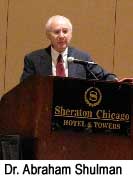 3 – Abraham Shulman, MD – Martha Entenmann Tinnitus Research Center, Brooklyn, NY
3 – Abraham Shulman, MD – Martha Entenmann Tinnitus Research Center, Brooklyn, NY
Erik Veirs, MD of the University of California, San Diego, delivered Dr. Shulman’s presentation. He discussed quantitative electroencephalography (EEG) for tinnitus characterization. This involves brain imaging to objectively measure severe disabling tinnitus in the brain. EEG records surface electrical potential in brain structures. EEG and Quantitative EEG (QEEG) are used to determine levels of tinnitus before and after TMS treatment.
4 – Tobias Kleinjung, MD – University of Regensburg, Regensburg, Germany
Dr. Kleinjung discussed his experiences using TMS for tinnitus. Tinnitus displays increased metabolic activity in the auditory cortex. The TMS magnetic field passes through the skull and influences cortical activity. The reduction of increased activity should reduce tinnitus.
Dr. Kleinjung and associates conducted a pilot study of TMS for tinnitus. It reduced tinnitus for many patients and the reduction lasted for up to six months. It was extremely expensive due to the use of advanced imaging to conduct neuronavigation to pinpoint where the stimulation was to occur.
They eliminated the neuronavigation and conducted a new pilot study with the same results. Some patients had good response but many had no benefit. They attempted to isolate the reasons and found that those with long-term tinnitus had poor results. Best results were seen in those who had no hearing loss.
Dr. Kleinjung said that there are seven other studies currently underway. Half the patients seem to have a good response. The results depend on the duration of their tinnitus. Individuals with early onset tinnitus (four years or less) tend to respond better than those with longer term tinnitus. They found they had more prolonged effects if they stimulated both the frontal and the temporal lobes.
5 – John Dornhoffer, MD, University of Arkansas, Little Rock, AR
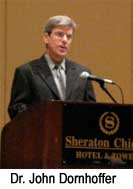 Dr. Dornhoffer discussed ways to prolong the positive effects of TMS. There are four parameters that influence the effectiveness: frequency of stimulation, intensity of the magnetic field, number of pulses and the coil configuration of the magnet.
Dr. Dornhoffer discussed ways to prolong the positive effects of TMS. There are four parameters that influence the effectiveness: frequency of stimulation, intensity of the magnetic field, number of pulses and the coil configuration of the magnet.
He treated four patients in a sham-controlled study. All improved in the short term. A newer test had 10 patients in a placebo controlled crossover study. Five patients had a good response. Two of the five had a complete resolution in the opposite ear from the side treated.
Dr. Dornhoffer believes that 25% of patients may have continued relief by using TMS treatment periodically.
6 – Guest of Honor: Dirk De Ridder, MD, University of Antwerp, Belgium
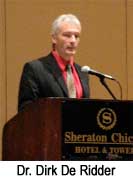 Dr. De Ridder presented a paper detailing the progress in tinnitus research from basic science, to non-invasive TMS therapy, to brain surgery. He said that if TMS can suppress tinnitus short-term, then an electrode implanted in the brain would provide long-term relief.
Dr. De Ridder presented a paper detailing the progress in tinnitus research from basic science, to non-invasive TMS therapy, to brain surgery. He said that if TMS can suppress tinnitus short-term, then an electrode implanted in the brain would provide long-term relief.
Dr. De Ridder implants electrodes in patients with severe, disabling tinnitus. He had success with a 38 year-old male who had tinnitus for 2.5 years. He used functional MRI for neuronavigation.
He stated that the longer tinnitus exists, the worse the results. This is because the auditory system changes over time and eventually tinnitus becomes somewhat “hard-wired”, becoming more difficult to treat. He believes the cut-off time for successful treatment is four years.
(Editors Note) Michael Seidman, MD, FACS, has been engaged in a series of experiments designed to show that electrodes implanted directly into the human brain can relieve tinnitus. An article on Dr. Seidman’s experimental new treatment can be found within our Tinnitus Library.
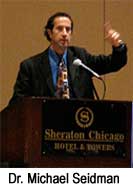 7 – Panel Discussion – Michael Seidman, Dirk Dr Ridder, Tobias Kleinjung, John Dornhoffer, Abraham Shulman
7 – Panel Discussion – Michael Seidman, Dirk Dr Ridder, Tobias Kleinjung, John Dornhoffer, Abraham Shulman
The panel discussed the present state of TMS research. They all acknowledge that it is in a research state, not yet a clinical application.
In cases of long-term tinnitus, TMS doesn’t change the auditory cortex as much as in short-term tinnitus. A possible approach to rectify this may be to address other targets in the brain. Using two magnets, one on the auditory cortex and one on another target, may prove helpful.
The distress caused by tinnitus occurs in a totally separate area of the brain. The limbic system is involved rather than the auditory cortex. Panelists postulated that TMS directed at the limbic system may reduce distress.
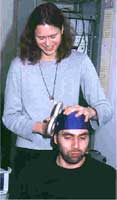 TMS only penetrates 2–3 cm into the brain. The auditory cortex is deeper than this. It is targeted but only indirectly affected. Currently “Figure 8” magnetic coils are mostly used. “H” coils may provide deeper penetration.
TMS only penetrates 2–3 cm into the brain. The auditory cortex is deeper than this. It is targeted but only indirectly affected. Currently “Figure 8” magnetic coils are mostly used. “H” coils may provide deeper penetration.
Recent onset tinnitus responds best to high frequency TMS. Long-term tinnitus, though more difficult to treat, responds better to low frequency TMS.
The panelists agreed that the frequency, intensity and duration of the stimulation all need to be explored further.
I hope from this discussion that the reader obtains a better understanding of the progress in tinnitus research and the obstacles yet to be overcome. Many people ask the question “Why isn’t more research being done for tinnitus”. Well, there is a great deal of research being conducted. It’s a very complicated field but advances are being made. While it appears that we are still several years away from a clinical treatment, there is a light at the end of the tunnel.
Get Free Shipping!
Order now and get free shipping on either the Tinnitus Starter Kit or Combo Pack. Try the doctor recommended products with clinically proven ingredients for tinnitus. No coupon code required.

